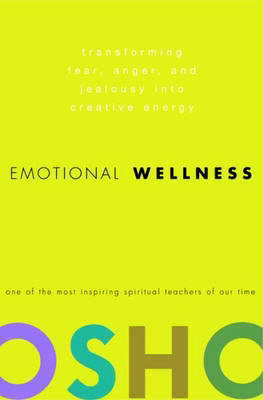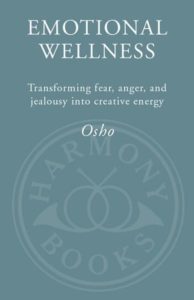
“Emotions cannot be permanent. That’s why they are called ‘emotions’ – the word comes from “motion,”movement. They move; hence, they are ‘emotions.’ From one to another you continually change. This moment you are sad, that moment you are happy; this moment you are angry, that moment you are compassionate. This moment you are loving, another moment full of hatred; the morning was beautiful, the evening is ugly. And this goes on.
This cannot be your nature, because behind all these changes something is needed like a thread that holds all of them together. Just as in a garland you see flowers, you don’t see the thread, but the thread is what is holding all the flowers, in the same way these emotions are all flowers. Sometimes anger flowers, sometimes happiness, sometimes pain sometimes anguish. But these are all flowers, and your whole life is the garland. There must be thread; otherwise you would have fallen apart long ago. You continue as an entity – so what is the thread, the polestar? What is permanent in you?” Osho
Osho, one of the most inspiring spiritual teachers of our time.
Emotional Wellness:
How do we reconcile our need to express our emotions with our desire to protect others? Far too often we find ourselves trapped in this dilemma of expression versus repression.
Emotional Wellness
Osho heeft het in dit boek Emotional Wellness over het tijdelijke karakter van emoties. Dat blijkt al uit het woord: ze zijn ‘in movement’, voortdurend in verandering. In plaats van erin te blijven steken of erger nog: ze te onderdrukken, kunnen we ze omzetten in creatieve energie. Osho heeft het in dit boek ‘Emotional Wellness’ over het tijdelijke karakter van emoties. Dat blijkt al uit het woord ‘emoties’: ze zijn ‘in movement’, ze zijn voortdurend in verandering. Het ene moment zijn we liefdevol, het andere moment voelen we diepgaande haat. Soms zijn we narrig en nukkig, dan weer zijn we opgewekt en vrolijk. Daaruit blijkt dat emoties niet ons wezen betreffen, maar van voorbijgaande aard zijn.
En juist dit feit geeft aan dat we emoties kunnen transformeren. We kunnen 
beladen emoties als angst, boosheid en jaloezie omzetten in creatieve energie. Dat kan op hele eenvoudige manieren, namelijk door creatief te zijn.
Als we namelijk onze energie niet helemaal gebruiken, gaat deze automatisch naar het oude stromen. En dat betreft meestal negatieve zaken en de emoties die daarbij horen.
Door op de manier creatief te zijn die ons ligt, besteden we die energie en transformeren we het negatieve. Dat kan gebeuren door te schilderen, te schrijven, te dansen en door bijvoorbeeld in de tuin te werken en bloemen te planten.
Het prachtige beeld dat Osho bij emoties geeft, is, dat emoties de bloemen van een guirlande vormen. Soms bloeit de ene bloem en dan de andere. Maar er moet een draad zijn die de bloemen bij elkaar houdt.
Was dat niet het geval, dan zouden we immers al lang uit elkaar gevallen zijn.
En dat is niet het geval. We blijven gewoon bestaan. Wat is de draad, wat is er eeuwig in ons? Dat is de opgave waarvoor we als mens in de spirituele zoektocht voor komen te staan, namelijk: het onsterfelijke vinden, dat wat niet vergaat en een het karakter van eeuwigheid heeft.
Het boek Emotional Wellness is bij de Nederlandse boekhandel te bestellen.
Impressie uit Emotional Wellness
How do we reconcile our need to express our emotions with our desire to protect others? Far too often we find ourselves trapped in this dilemma of expression versus repression. We fear that by expressing our true feelings, we will hurt and alienate those close to us. But by repressing our emotions – even in the benevolent guise of “self-control” – we only risk hurting ourselves.
Osho provides here a practical and comprehensive approach to dealing with this conflict effectively. Incorporating new, never-before-published material, Emotional Wellness leads us to understand the roots of our emotions, to react to situations in a way that can teach us more about ourselves and others, and to respond to life’s inevitable ups and downs with far greater confidence and equilibrium.
with this conflict effectively. Incorporating new, never-before-published material, Emotional Wellness leads us to understand the roots of our emotions, to react to situations in a way that can teach us more about ourselves and others, and to respond to life’s inevitable ups and downs with far greater confidence and equilibrium.
Discover:
The impact that fear, anger, and jealousy have on our lives
How emotions like guilt, insecurity, and fear are used to manipulate us
How to break out of unhealthy responses to strong emotions
How to transform destructive emotions into creative energy
The role of society and culture on our individual emotional styles
Osho’s unique insight into the human mind and heart goes far beyond conventional psychology. He teaches us to experience our emotions fully and to deal with them creatively in order to achieve a richer, fuller life.
“Emotions cannot be permanent. That’s why they are called ‘emotions’ – the word comes from “motion,”movement. They move; hence, they are ‘emotions.’ From one to another you continually change. This moment you are sad, that moment you are happy; this moment you are angry, that moment you are compassionate. This moment you are loving, another moment full of hatred; the morning was beautiful, the evening is ugly. And this goes on. This cannot be your nature, because behind all these changes something is needed like a thread that holds all of them together. Just as in a garland you see flowers, you don’t see the thread, but the thread is what is holding all the flowers, in the same way these emotions are all flowers. Sometimes anger flowers, sometimes happiness, sometimes pain sometimes anguish. But these are all flowers, and your whole life is the garland. There must be thread; otherwise you would have fallen apart long ago. You continue as an entity – so what is the thread, the polestar? What is permanent in you?” Osho
